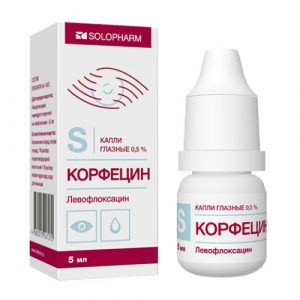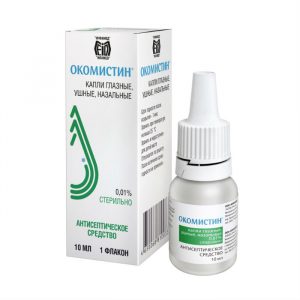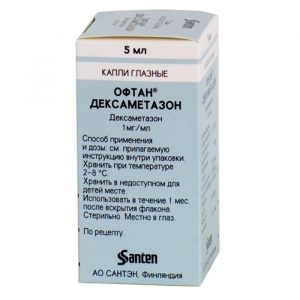Description
Release form
Eye drops 0.5%.
5 ml, 10 ml polymeric dropper bottles made of high pressure polyethylene with screw neck, dropper stopper made of low pressure polyethylene and a screw cap with a control ring for the first opening of low pressure polyethylene.
5 ml, 10 ml in polymeric dropper bottles made of high pressure polyethylene with a screw neck, dispensing nozzle made of high pressure polyethylene and a screw cap with a control ring of the first opening made of polypropylene or polymeric dropper bottles made of high pressure polyethylene with a screw neck, dispensing nozzle made of high-pressure polyethylene and a screw-on cap with a control ring of the first opening of low-pressure polyethylene.
1 polymer dropper bottle, together with instructions for use, is placed in a pack of cardboard.
Pharmacological action
Pharmacodynamics.
Moxifloxacin is a fourth-generation fluoroquinolone antibacterial drug that has a bactericidal effect. It is active against a wide range of gram-positive and gram-negative microorganisms, anaerobic, acid-resistant and atypical bacteria.
The mechanism of action is associated with the inhibition of topoisomerase II (DNA gyrase) and topoisomerase IV. DNA gyrase is an enzyme involved in the replication, transcription and repair of bacterial DNA. Topoisomerase IV is an enzyme involved in the cleavage of chromosomal DNA during bacterial cell division.
Mechanisms for the development of resistance
Resistance to antibiotics of the fluoroquinolone series, including moxifloxacin, develops through chromosomal mutations in genes, encoding DNA gyrase and topoisomerase IV. In gram-negative bacteria, resistance to moxifloxacin is associated with mutations in the system of multiple resistance to antibiotics and the system of resistance to quinolones. The development of resistance is also associated with the expression of efflux proteins and inactivating enzymes. Cross-resistance with macrolides, aminoglycosides and tetracyclines is not expected due to differences in the mechanism of action. The development of resistance can have significant geographical differences, as well as vary significantly at different periods of time, and therefore, before starting therapy, it is necessary to obtain information about the resistance of microorganisms in a particular area, which is of particular importance in the treatment of severe infections.
Moxifloxacin is active against most strains of microorganisms (both in vitro and in vivo): Gram-positive bacteria: Corynebacterium spp., including Corynebacterium diphtheriae
Micrococcus luteus (including strains that are insensitive to erythromycin / trimethrycin or gentricin aureus (including strains insensitive to methicillin, erythromycin, gentamicin, ofloxacin, tetracycline and / or trimethoprim)
Staphylococcus epidermidis (including strains insensitive to methicillin, erythromycin, gentamicin, ofloxacin, tetracycline accept)
Staphylococcus haemolyticus (including strains insensitive to methicillin, erythromycin, gentamicin, ofloxacin, tetracycline and / or trimethoprim)
Staphylococcus hominis (including strains, insensitive to methicillin, erythromycin, gentamicin, ofloxacin, tetracycline and / or trimethoprim)
Staphylococcus warneri (including erythromycin insensitive strains)
Streptococcus mitis (including strains that are not sensitive to penicillin / streocericides, tritericides including strains insensitive to penicillin, erythromycin, gentamicin, tetracycline and / or trimethoprim)
Streptococcus viridans group (including strains insensitive to penicillin, erythromycin, tetracycline and / or trimethoprim).
Gram-negative bacteria: Acinetobacter lwoffii Haemophilus influenzae (including ampicillin-insensitive strains) Haemophilus parainfluenzae Klebsiella spp.
Other microorganisms: Chlamydia trachomatis
Moxifloxacin acts in vitro against most of the microorganisms listed below, but the clinical significance of these data is not known: Gram-positive bacteria: Listeria monocytogenes Staphylococcus saprophyticus Streptococcus agalactiae Streptococcus mucetocobactericobacteridae streptococcus mitis Streptocococcus colocetocobactericobacteridae Streptocococcus fibrenetida streptococcus mucidae Citrobacter koseri Enterobacter aerogenes Enterobacter cloacae Escherichia coli Klebsiella oxytoca Klebsiella pneumoniae Moraxella catarrhalis Morganella morganii Neisseria gonorrhoeae Proteus mirabilis Proteus vulgaris Pseudomonas struterobridum sulphobridrobloid Prevotella spp. Propionibacterium acnes.
Other microorganisms: Chlamydia pneumoniae Legionella pneumophila Mycobacterium avium Mycobacterium marinum Mycoplasma pneumoniae.
There is no data on the relationship between the clinical and bacteriological outcome of infectious diseases of the organ of vision during treatment with moxifloxacin. According to the epidemiological data of the European Committee for the Determination of Antimicrobial Sensitivity, the threshold values of the inhibitory concentration of moxifloxacin for various microorganisms are as follows: Corynebacterium – no data
Staphylococcus aureus – 0.25 mg / l
Staphylococcus, coag-neg. – 0.25 mg / l
Streptococcus pneumoniae – 0.5 mg / l
Streptococcus pyogenes – 0.5 mg / l
Streptococcus viridans group – 0.5 mg / l
Enterobacter spp. 0.25 mg / l
Haemophilus influenzae 0.125 mg / l
Klebsiella spp. – 0, 25 mg / l
Moraxella catarrhalis – 0.25 mg / l
Morganella morganii – 0.25 mg / l
Neisseria gonorrhoeae – 0.032 mg / l
Pseudomonas aeruginosa – 4 mg / l
Serratia marcescens – 1 mg
Pharmacokinetics.
When applied topically, moxifloxacin is systemically absorbed: the maximum plasma concentration of moxifloxacin (Cmax) is 2.7 ng / ml, the area under the concentration-time curve (AUC) is 45 ng * h / ml. These values are approximately 1600 times and 1000 times less than Cmax and AUC after the administration of a therapeutic dose of 400 mg of moxifloxacin orally. The plasma half-life (T1 / 2) of moxifloxacin from plasma is about 13 hours.
Indications
Bacterial conjunctivitis caused by microorganisms sensitive to moxifloxacin.
Special instructions
For ophthalmic use only. Not for injection. The introduction of the drug subconjunctival or directly into the anterior chamber of the eye is not allowed.
There have been reports of the development of serious and, in some cases, fatal hypersensitive (anaphylactic) reactions in patients who systematically took quinolones in some patients, the development of the reaction was observed after the first dose. Some reactions were accompanied by cardiovascular failure, loss of consciousness, Quincke edema (including swelling of the larynx, pharynx, or face), airway obstruction, dyspnea, urticaria, and itching.
If you develop an allergic reaction to the drug Moxifloxacin-Optic, you should stop using the drug. In case of serious acute hypersensitivity reactions, immediate resuscitation measures may be required: oxygen therapy may be necessary with indications of airway management
Prolonged use of the antibiotic can lead to an overgrowth of refractory microorganisms, including fungi. In case of superinfection, it is necessary to stop the use of the drug and prescribe adequate therapy.
Systemic use of fluoroquinolones, including moxifloxacin, can lead to inflammation and rupture of tendons, especially in elderly patients and individuals concomitantly taking corticosteroids. Thus, when the first symptoms of tendon inflammation appear, you should stop taking the drug.
Data on the efficacy and safety of the drug Moxifloxacin-Optic for the treatment of conjunctivitis in newborns are limited. Therefore, it is not recommended to use the drug for the treatment of conjunctivitis in newborns.
Moxifloxacin-Optic is not recommended for prophylaxis or empirical therapy of conjunctivitis, including neonatal gonococcal ophthalmia, due to the fluoroquinolone resistance of Neisseria gonorrhoeae gonococci. Patients with ocular infections caused by Neisseria gonorrhoeae gonococcus should receive appropriate systemic treatment.
Moxifloxacin-Optic is not recommended for the treatment of eye infections caused by Chlamidia trachomatis, in patients under the age of 2 years, since relevant studies have not been conducted.
Patients older than 2 years with eye infections caused by Chlamidia trachomatis should receive appropriate systemic treatment.
Newborns with ophthalmia of newborns should receive appropriate treatment based on their condition, for example, systemic treatment in cases caused by gonorrhea of ² ¹ ² ¹Chlamidia trachomatis or Neisseria gonorrhoeae.
Patients are not recommended to wear contact lenses if they have signs of infectious diseases of the anterior segment of the eyeball.
The bottle must be closed after each use.
Impact on the ability to drive vehicles and mechanisms.
After using the drug, a decrease in the clarity of visual perception is possible, and until it is restored, it is not recommended to drive a car and engage in activities that require increased attention and reaction.
Composition
Active ingredient:
minoxidil 20 mg
Excipients:
ethanol (96 mg srdlpff991996prfpfp29 – 96 mg pfdlpfp – 96 mg Composition
Active ingredient:
Moxifloxacin hydrochloride
in terms of moxifloxacin
– 5.45 mg
– 5.00 mg
Excipients:
sodium chloride
– 6.4 mg
hydrochloric acid 3 mg
hydrochloric acid 3 – solution of 1 M or sodium hydroxide solution of 1 M srd lkp to pH 6.3 – 7.3
purified water
to 1.0 ml
Dosage and Administration
Topically.
Use in adults (including elderly patients over 65)
1 drop 3 times a day in the affected eye. Improvement occurs after 5 days of therapy, but treatment should be continued for another 2-3 days. In the absence of a therapeutic effect after 5 days of therapy, it is recommended to reconsider the diagnosis and choice of treatment tactics. The duration of the course of therapy depends on the severity of the patient’s condition, the clinical and bacteriological characteristics of the infectious process.
Use in the pediatric population
No dosage adjustment required for use in children.
Hepatic and renal failure
Dose adjustment not required.
To prevent microbial contamination of the tip of the dropper bottle and the drug, it is necessary to avoid contact with the eyelids, the skin of the peri-ocular area and other surfaces.
In order to prevent absorption of the drug through the nasal mucosa, it is necessary to squeeze the nasolacrimal canal with a finger for 2-3 minutes after instillation.
When using several topical preparations in ophthalmology, the interval between their use should be at least 5 minutes, eye ointments should be used last.
Side effects
The following adverse reactions are classified according to the following gradation of frequency of occurrence: very often (? 1/10), often (from? 1/100 to <1/10), infrequently (from? 1/1000 to < 1/100), rarely (from? 1/10 000 to <1/1 000), very rarely (<1/10 000). In each group according to the frequency of development, adverse reactions are presented in descending order of their severity. Disorders of the blood and lymphatic system Rarely: decreased hemoglobin level. Disorders of the nervous system Infrequently: headache. Rarely: paresthesia. Visual disturbances Often: pain, irritation in the eyes. Infrequently: point keratitis, dry eye syndrome, conjunctival hemorrhage, eye hyperemia, itching in the eyes, swelling of the eyelids, discomfort in the eyes. Rarely: corneal epithelial defects, corneal disorders, conjunctivitis, blepharitis, eye swelling, conjunctival edema, blurred vision, decreased visual acuity, asthenopia, eyelid erythema. Violation of the respiratory system, chest and mediastinal organs Rarely: discomfort in the nose, pharyngolaryngeal pain, foreign body sensation (in the throat). Disorders of the gastrointestinal tract Infrequently: dysgeusia. Rarely: vomiting. Violation of the liver and biliary tract Rarely: elevated levels of alanine aminotransferase and gammaglutamyl transferase. Post-marketing experience (frequency unknown): Immune system disorders Hypersensitivity. Violation of the nervous system Dizziness. Visual disturbances Ulcerative keratitis, keratitis, increased lacrimation, photophobia, discharge from the eyes. Heart abnormalities Sensation of a heartbeat. Disorders of the respiratory system, chest and mediastinal organs Dispnea. Disturbance of the gastrointestinal tract Nausea. Violation of the skin and subcutaneous tissue Erythema, pruritus, rash, urticaria. Drug Interactions The interaction of locally prescribed moxifloxacin with other drugs has not been studied. Due to the low systemic concentration after topical application in the form of instillations, interaction with other drugs is unlikely. Data are known for the oral dosage form of moxifloxacin: there are no clinically significant drug interactions (unlike other fluoroquinolone drugs) with theophylline, warfarin, digoxin, oral contraceptives, probenicide, ranitidine and glibenclamide. In vitro studies, moxifloxacin does not inhibit the CYP3A4, CYP2D6, CYP2C9 or CYP1A2 isoenzymes, which may indicate that moxifloxacin does not alter the pharmacokinetic properties of drugs metabolized by the cytochrome P450 isoenzymes. Overdose Due to the low capacity of the conjunctival cavity, the possibility of developing local overdose when using drugs in the form of instillations is practically absent. The total content of moxifloxacin in the preparation is too low for the development of adverse events if the contents of the vial are accidentally swallowed. In case of excessive eye contact, rinse eyes with warm water. Storage conditions Store at a temperature not exceeding 25 ° C. Keep out of the reach of children. Store in the original packaging. Expiration 2 years. Deystvuyuschee substances Moxifloxacin Terms of delivery from pharmacies Prescription Dosage form rims glazn e




